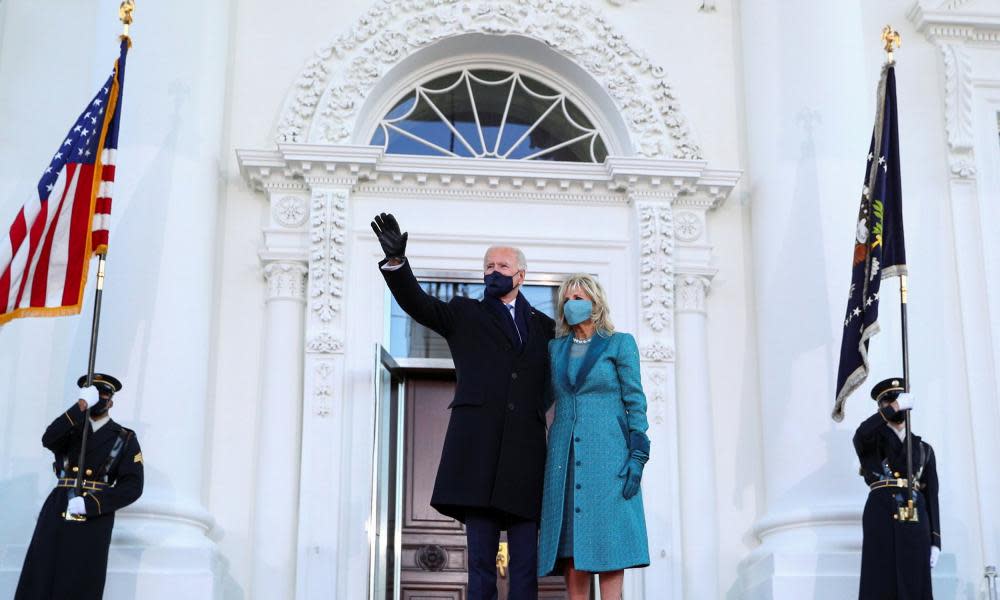Fight to vote: Biden moves to fix US census less than 24 hours after taking office

Happy Thursday,
After an inauguration in which Amanda Gorman left America breathless with her poetry, Lady Gaga and Jennifer Lopez sparkled, and Bernie Sanders, well, was Bernie Sanders, today is the first full day of Joe Biden’s presidency.
Moving forward from an election in which there was record turnout and Republicans made a deliberate and concerted effort to overturn the results, voting rights are set to be a major agenda item for Democrats as they take control of the federal government. There are already efforts percolating in some states to make it harder to vote. And less than 24 hours after he took office, Biden took action on one major item.
Fixing the census
On Wednesday, the president signed an executive order blocking the Census Bureau from excluding undocumented immigrants from the apportionment data used to determine how many seats in Congress each state gets. The move essentially ends a years-long effort by the Trump administration to get the Census Bureau to collect citizenship data that states could in turn use to diminish the political power of immigrants. The United States has long followed the constitutional mandate to apportion seats based on “the whole numbers of persons in each state”, and civil rights groups aggressively challenged the measure in court.
“I thunderously applaud the Biden administration’s action on day one to rescind the Trump’s administration’s directive to compile data on non-citizens for partisan purposes. While legal challenges and logistical challenges never allowed the directive to have its effect, it marred the 2020 census,” said Arturo Vargas, CEO of the Naleo educational fund.
As NPR noted, Biden’s order does not address separate instructions from Wilbur Ross, the former commerce secretary, ordering the Census Bureau to produce block level citizenship data states could use for redistricting if they want. Drawing districts based only on the voting eligible population, not all voters, “would be advantageous to Republicans and Non-Hispanic Whites,” a top GOP redistricting strategist wrote in 2015.
Meanwhile, on Capitol Hill
Chuck Schumer, the Senate Democratic leader, announced on Tuesday that they would push ahead with legislation with a slew of significant voting reforms that would amount to the most dramatic overhaul of America’s election laws in decades.
From a violent insurrection to countless attempts to suppress votes:
Attacks on democracy have come in many forms.
The first bill the @SenateDems majority will introduce will be the #ForThePeople Act to renew democracy, end big money in politics, and tackle corruption. #S1— Chuck Schumer (@SenSchumer) January 19, 2021
Among other provisions, the legislation, which passed the US House in 2019, would:
Require early voting and same-day registration for federal elections.
Require states to automatically register voters who interact with certain state agencies and place limits on how aggressively states can remove voters from the rolls
Require states to set up independent commissions to draw congressional districts, reducing the potential for excessive partisan gerrymandering.
Democrats are also expected to pursue separate legislation to restore a key provision of the Voting Rights Act that required places with a history with voting discrimination to pre-clear voting changes before they go into effect.
But as things stand right now, Democrats won’t be able to pass either bill unless they can get 10 Republicans to sign on and overcome a Senate filibuster, a procedural move that can be used to hold up legislation.
Also worth watching …
More than a dozen civil rights groups in Georgia called for the resignation of a Republican election official in Gwinnett county, a battleground outside Atlanta that has shifted Democratic in recent years. Alice O’Lenick is currently serving as the chair of the elections board in Gwinnett county and recently called for Republicans to change voting laws in the state so “we at least have a shot at winning”, according to the Gwinnett Daily Post.
After the 2020 election, Ohio removed nearly 98,000 voters from its rolls as part of its regular process to keep voter information up to date, according to Cleveland.com. But what struck me about the story is that there were initially more than 115,000 people set to be removed, but more than 10,000 people prevented themselves from being purged by voting in November. That means there were at least 10,000 eligible voters who the state nearly purged erroneously. While the Ohio secretary of state, Frank LaRose, a Republican, has earned praise for publishing the list of people set to be purged before they are removed, such a high error rate suggests that Ohio’s process for flagging ineligible voters is prone to mistakes and could disenfranchise voters.

 Yahoo News
Yahoo News 
